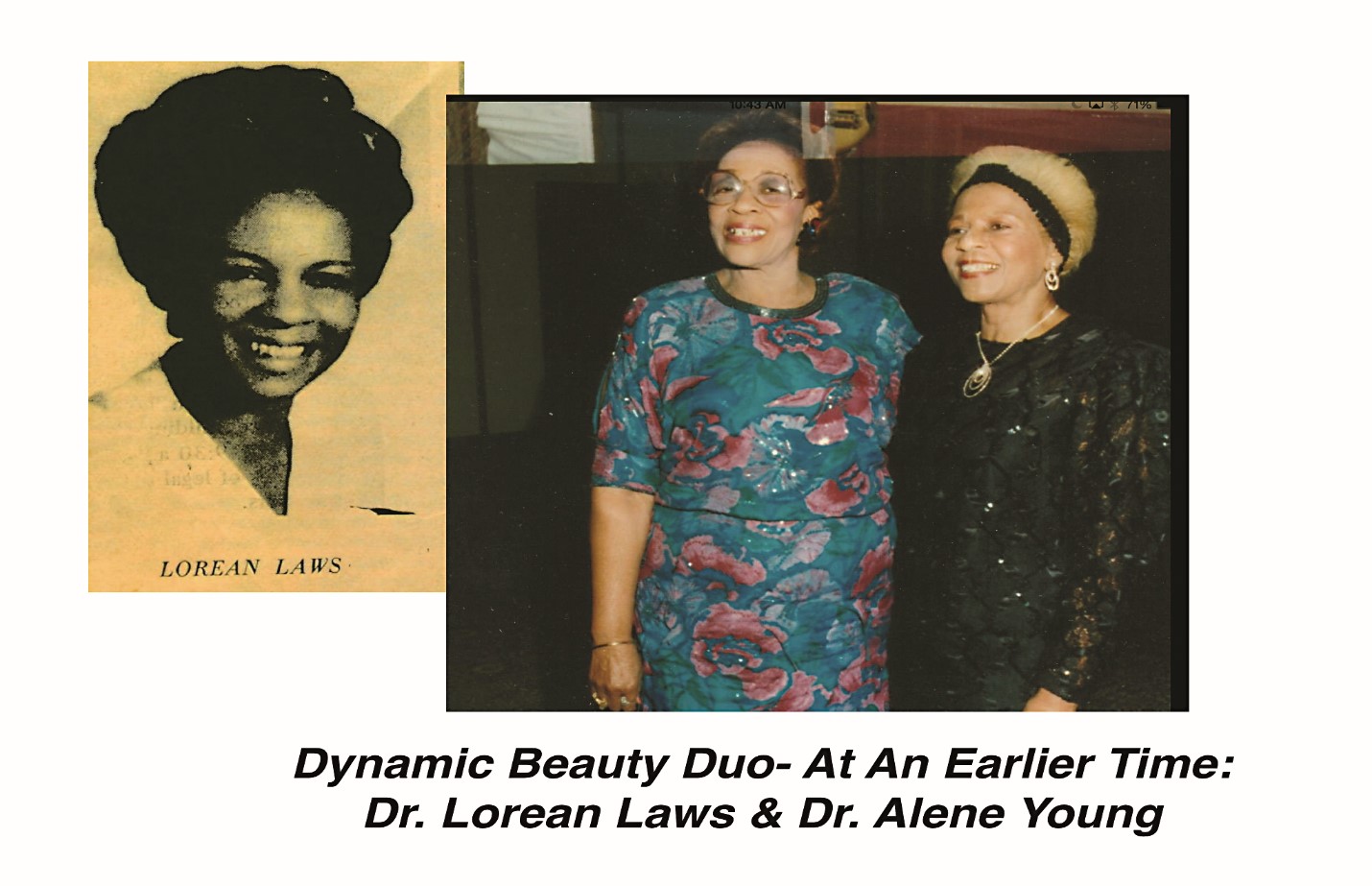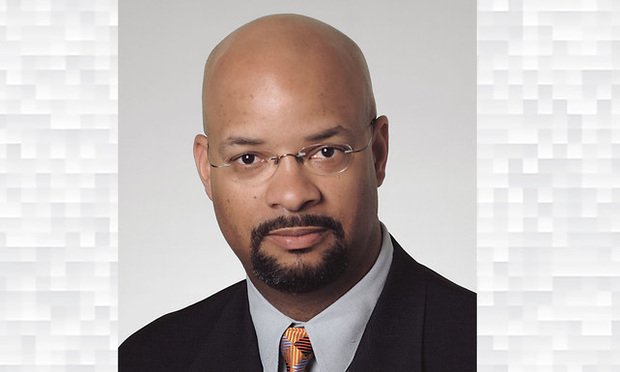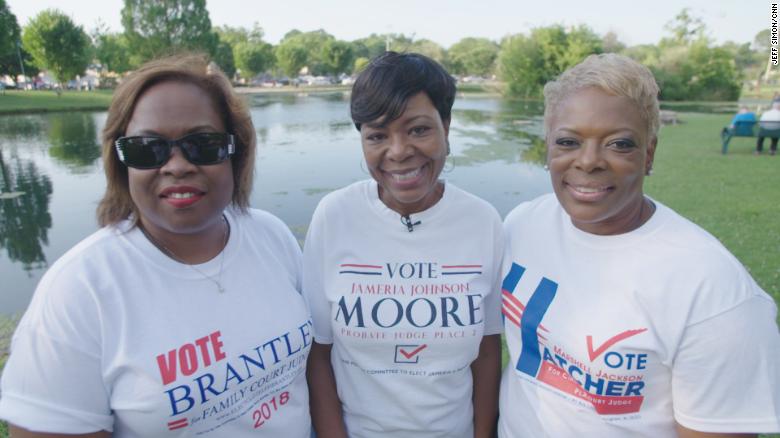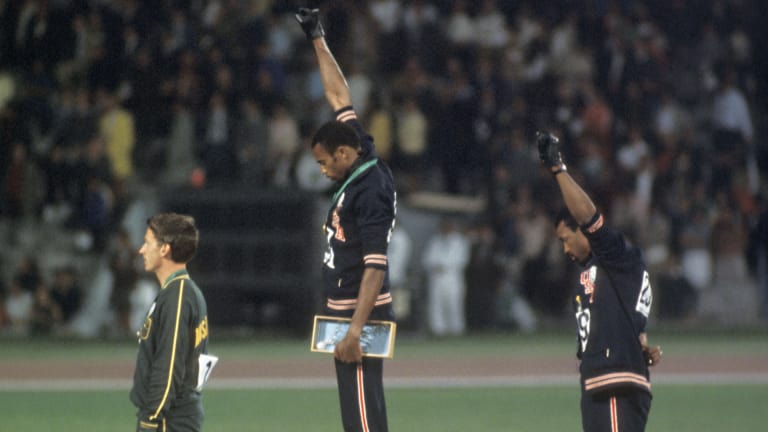
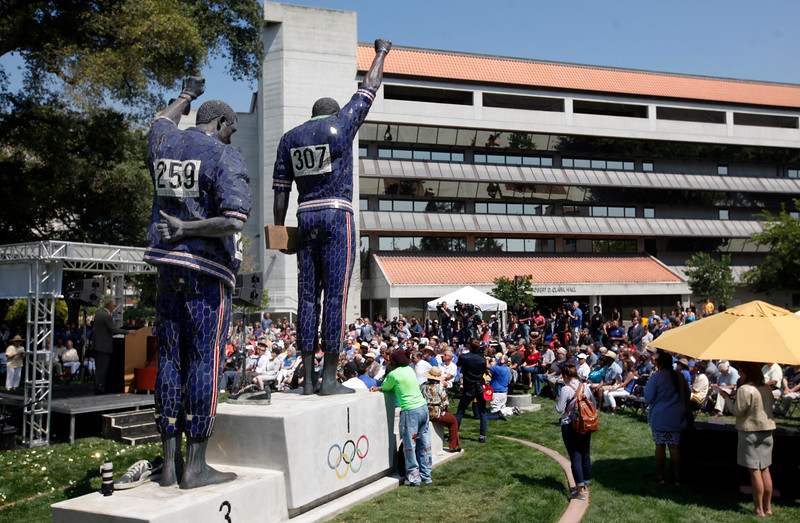
It was Oct. 16, 1968. Smith had just won gold and Carlos had taken bronze in a blazing 200-meter dash. Australian sprinter Peter Norman, who had won silver, stood to their right.
When “The Star-Spangled Banner” began to play, Smith lowered his head and raised his right fist.
Carlos raised his left.
Life magazine photographer John Dominis raised his lens.
Click.
Dominis’s photograph would freeze that moment of silent protest. The picture would slingshot around the world, capturing all the angst and anger of 1968. The photo would become an iconic image of the Black Power movement and an emotional reference point among NFL players who kneel during the national anthem to protest police brutality.
Dominis, who died in 2013, said later he had no idea in that stadium in 1968 that his shot would make history. “I didn’t think it was a big news event,” Dominis said in a 2008 interview with the Smithsonian Magazine. “I hardly noticed what was happening when I was shooting.”
Other photographers, standing in the media-holding pen a few feet away, also captured the moment. But Dominis seized on searing details that made his image more powerful. His photo shows Smith, his pant legs rolled up, standing in black stocking feet, his right shoe resting on the podium.
“It was a cry for freedom,” Smith said in a 2016 interview with the Smithsonian’s Museum of African American History and Culture, which acquired the tracksuit he was wearing that day, along with the shoes he raced in, and the box he held on the podium, which contained an olive tree branch.
Carlos wore a long string of beads falling from his neck, his jacket unzipped in utter defiance of Olympic rules.
And the photo illuminates the subtle expression on Norman’s face. Few realized that Norman was also part of the protest. Norman wore a small badge on his chest: “Olympic Project for Human Rights,” which had been organized to protest racism in sports.
The protest had been something the athletes planned carefully. Everything captured in the photo held a special significance. Smith and Carlos had walked slowly to the stand as if in mourning, their hands clasped behind their backs — each holding a running shoe. They walked across the grass of the stadium in black stocking feet. They had taken off their shoes specifically to protest poverty in the United States.
To protest lynchings of black people, they wore a scarf and beads. “I looked at my feet in my high socks and thought about all the black poverty I’d seen from Harlem to East Texas,” Carlos wrote in his 2011 book written with Dave Zirin, “The John Carlos Story: The Sports Moment That Changed the World.”
“I fingered my beads and thought about the pictures I’d seen of the ‘strange fruit’ swinging from the poplar trees of the South.”
They bowed respectfully as the Olympic official placed their medals around their necks. But when the anthem began to play, they lowered their heads to protest the hypocrisy of a country that proclaimed to uphold freedom and human rights around the world but neglected to protect the rights of black Americans. Carlos unzipped his Olympic jacket, in defiance of Olympic etiquette, but in support of “all the working-class people — black and white — in Harlem who had to struggle and work with their hands all day.”
Carlos had deliberately covered up the “USA” on his uniform with a black T-shirt to “reflect the shame I felt that my country was traveling at a snail’s pace toward something that should be obvious to all people of good will. Then the anthem started, and we raised our fists into the air.”
When Smith thrust his fist in the air, the crowd fell silent. Carlos and Smith recalled later that they knew by openly defying Olympic rules, there would be repercussions.
Some people look at the photo and wonder why Smith is raising his right hand and Carlos is raising his left. The answer is this: One of them had forgotten his gloves, so they were sharing the one pair they had.
It was Norman who had suggested they split the pair of gloves.
“The stadium became eerily quiet,” Carlos wrote. “For a few seconds, you honestly could have heard a frog piss on cotton. There’s something awful about hearing fifty thousand people go silent, like being in the eye of a hurricane.”
As the national anthem played, the crowd began to boo them. Then some people in the crowd began to scream the national anthem. The punishment for defying Olympic rules was swift. Smith and Carlos were ordered to leave the Olympic stadium.
But the image of Smith and Carlos raising fists would become seared in history as an incendiary act of protest by athletes.
“Tommie and John putting their fists in the air was something that Americans really connected to because everyone was in some type of dissent in America to something,” Olympic gold medalist Edwin Moses said in the documentary “Black Power Salute.”
The Vietnam War was raging. American cities had erupted in riots after the assassination of Martin Luther King Jr. Sen. Robert F. Kennedy was gunned down two months later. That summer, the country had witnessed the televised beating of demonstrators by Chicago police outside the Democratic National Convention.
[A busboy held Bobby Kennedy after he was shot. The photo haunted him until his own death this week.] Tommie Smith, wearing black socks, celebrates crossing the finish line first in the men’s 200-meter sprint, ahead of Australian Peter Norman and U.S. teammate John Carlos on Oct. 16, 1968, during the Olympic Games in Mexico City. (AFP/Getty Images)
Tommie Smith, wearing black socks, celebrates crossing the finish line first in the men’s 200-meter sprint, ahead of Australian Peter Norman and U.S. teammate John Carlos on Oct. 16, 1968, during the Olympic Games in Mexico City. (AFP/Getty Images)
Carlos and Smith were ordered to leave Mexico City. When they returned to the United States, they were suspended from the U.S. track team and received death threats.
After their track careers, Smith and Carlos played professional football. Smith played one season with the Cincinnati Bengals, and Carlos played for one season in the Canadian Football League.
Smith, who worked at Santa Monica College as a sociology professor and track coach, said in an HBO documentary that they were just trying to bring attention to injustice in the United States.
“I don’t like the idea of people looking at it as negative,” Smith said. “There was nothing but a raised fist in the air and a bowed head, acknowledging the American flag — not symbolizing a hatred for it.”
Carlos, who worked as a guidance counselor at Palm Springs High School in California, told the Guardian newspaper: “I had a moral obligation to step up. Morality was a far greater force than the rules and regulations they had.”
In 2016, Smith and Carlos were finally invited to a Team USA Awards ceremony, the first Olympic Committee ceremony they had been invited to since 1968.

San Francisco 49ers safety Eric Reid, left, and quarterback Colin Kaepernick kneel during the national anthem before a game against the Los Angeles Rams in 2016. (Marcio Jose Sanchez/AP)
Smith and Carlos said they supported Colin Kaepernick and other football players who have knelt during the national anthem to protest police brutality.
“Don’t hate the kid because he stood up for something,” Smith told the audience, according to an Associated Press report. “He stood up for the right to exercise Amendment One.”
In April, Norman, who had been treated as an outcast in his country when he returned from the Olympics, was awarded the Order of Merit — the highest Olympic honor in Australia — by the Australian Olympic Committee. The honor was awarded posthumously to Norman, who died in 2006.




